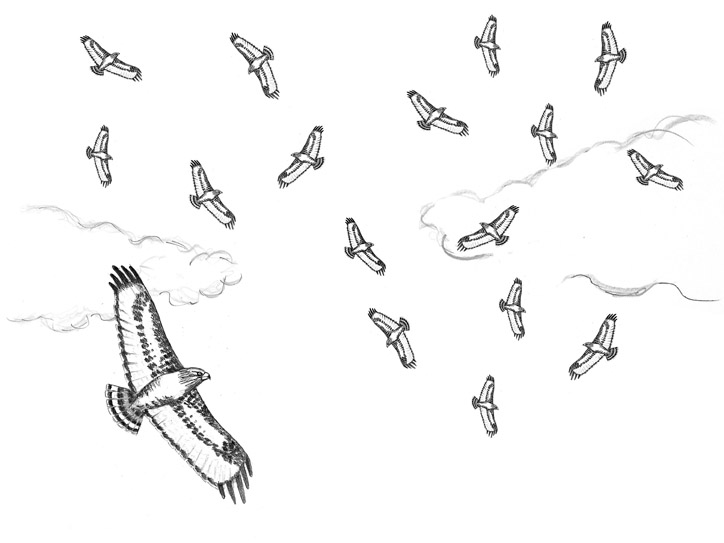
Dear Bird Folks,
Occasionally, a Cooper’s Hawk will chase the birds at our feeder. Today, however, a hawk ignored the birds and instead dove into our rather tall grass and came out with a chipmunk. Any idea what kind of hawk it is? (See attached photo.)
– Cass, Eastham, MA
Good for you, Cass,
I love that you have normal grass in your yard. You Outer Cape people, with your “Cape Cod lawns,” know what you are doing. You don’t waste your time and money spraying, watering and mowing, and the birds appreciate it. Other Cape towns could learn a lot from you. In my neighborhood the grass cutting never stops, even in the winter. I’m exaggerating a little, but not a lot. And here’s another thing about lawns… Oh, wait. You asked me something about a hawk. Sorry, I was distracted by the loud lawnmower that just went by.
The bird in your photo is a Broad-winged Hawk. Most of us are familiar with the Cooper’s Hawk, which, as you know, is a notorious songbird nemesis. We also see a lot of Red-tailed Hawks. But red-tails are too fat and slow to be a serious problem for quick little songbirds. Instead, red-tails mostly focus on squirrels and rabbits. Speaking of that: a few weeks ago I was sitting on my deck, having some “tea,” when I noticed a red-tail flying high above my house. In a split second the big raptor changed course and plunged straight down into our own tall grass and came out with a rabbit. The drama quickly became even more dramatic when a fox leapt out of the bushes and stole the rabbit from the hawk. It was an exciting scene to witness, although the hungry hawk wasn’t very happy about it…and the rabbit even less so.
Broad-winged Hawks, like red-tails, aren’t big time bird chasers. They are also considerably smaller than their red-tail cousins, so they don’t catch many adult rabbits either. Chipmunks are more their style, plus mice, toads, snakes and large insects. My 1985 Birds of Cape Cod checklist indicated that broad-wings were fairly common in these parts and their numbers were increasing. Unfortunately, the more recent 2021 checklist paints a different picture. The broad-wing population is actually declining locally. I don’t believe the turn down has been caused by anything ominous; it’s most likely the result of habitat changes (i.e.,too many lawns).
Like most hawks, broad-wings aren’t very flashy-looking, typically covered in an assortment of brown and white feathers. They are about the size of a Cooper’s Hawk, but aren’t as sleek as coops. Instead, broad-wings are stout and chunky, looking like a red-tail’s kid brother. While they do have fairly wide wings, the best field marks are the bold black and white bands on their tails. In addition to being less common than our other Cape Cod hawks, broad-wings are also less conspicuous. They spend their days sitting in trees, waiting for something delicious (chipmunks) to walk by. As inconspicuous as broad-wings are while hunting, the birds are more than obvious when migration season arrives. Then you can see one, two, four or several thousand at one time. Really.
Most hawk species migrate to some degree, but none are quite as dramatic as broad-wings. They not only leave Cape Cod in the fall, but, for the most part, they all leave North America as well. And when I say, “they all leave,” I mean all 1.5 million of them head out. Broad-winged Hawks are noted for their long-distance migration that takes them from Canada and the eastern half of the U.S., all the way down to South America. And because they all leave around the same time, and mostly follow the same route, there are some locations that see a crazy number of hawks in a very short period. This creates a spectacle for birders (and a big problem for chipmunks).
Songbirds tend to migrate at night, when the air is cooler and calmer, and when they can’t be seen by migrating hawks. Conversely, hawks are diurnal migrants; they like the sun’s heat and the turbulent air it creates. Warm columns of air, rising up from the ground help keep the soaring hawks aloft, allowing them to basically glide most of their way south. Since large bodies of water don’t provide the needed warm thermals, the birds stay over land as much as possible, following the coastline of Texas and on into Mexico. Along the Mexican coast they become pinched-in by the Sierra Madre Oriental mountains on their right and the Gulf of Mexico on their left. These natural obstacles funnel the birds over the port city of Veracruz. For a few weeks each year birders and researchers gather to watch the show, and what a show it is. Some days the numbers of passing hawks (and other birds) are spectacular and occasionally, the numbers are beyond spectacular. How many is beyond spectacular, you ask? I believe the record number of birds seen on a single day is 640,000. Although that number seems a little high to me, so they may have counted one bird twice.
The hawk in your photo is most likely on its wintering grounds by now, Cass. The Broad-winged Hawk’s long and impressive migration is pretty much over by the middle of October. For the next few months broad-wings will spend their days in the forests of Ecuador, Colombia and Brazil. Here they’ll sit in trees (while avoiding areas with manicured lawns) and search for mice, toads, snakes and, of course, South America’s version of chipmunks. No matter the country or the continent, chipmunks can’t get a break.